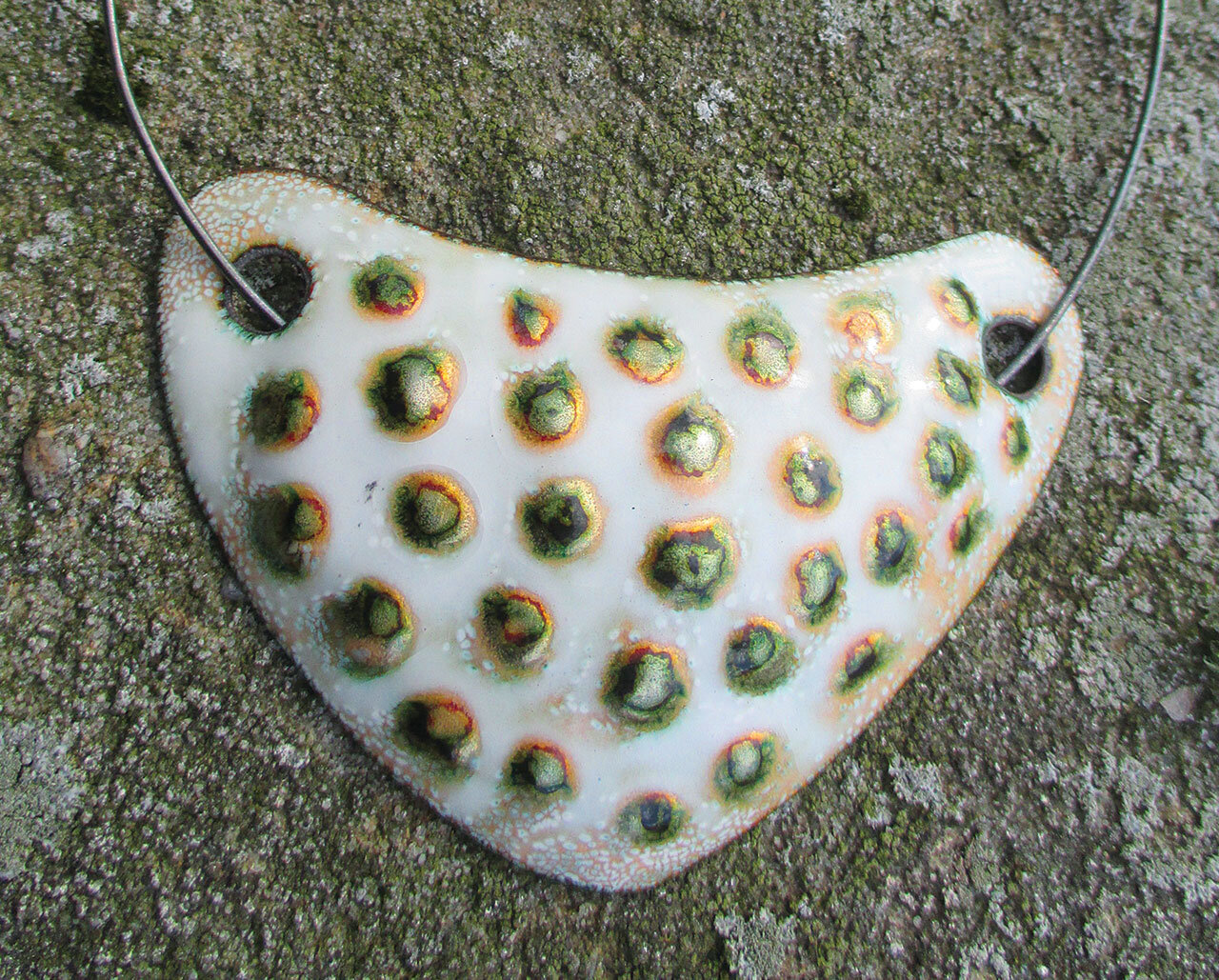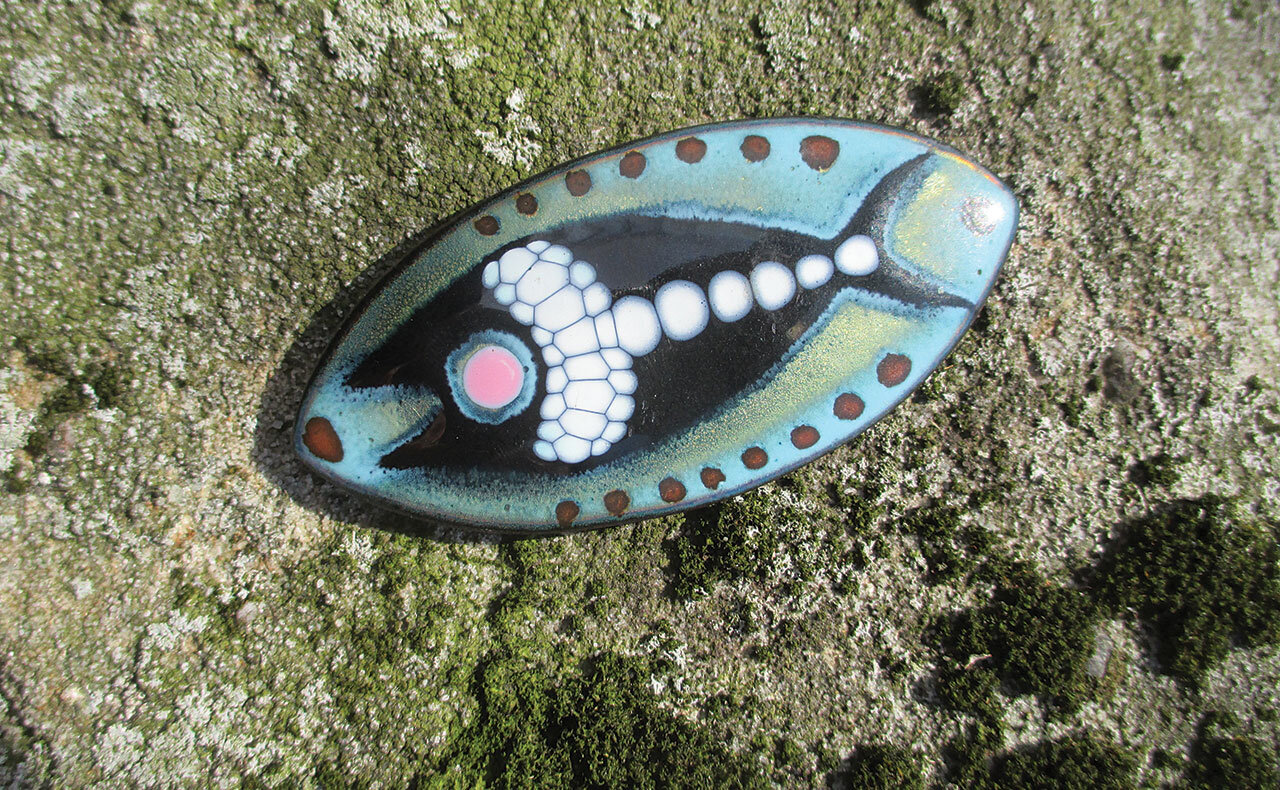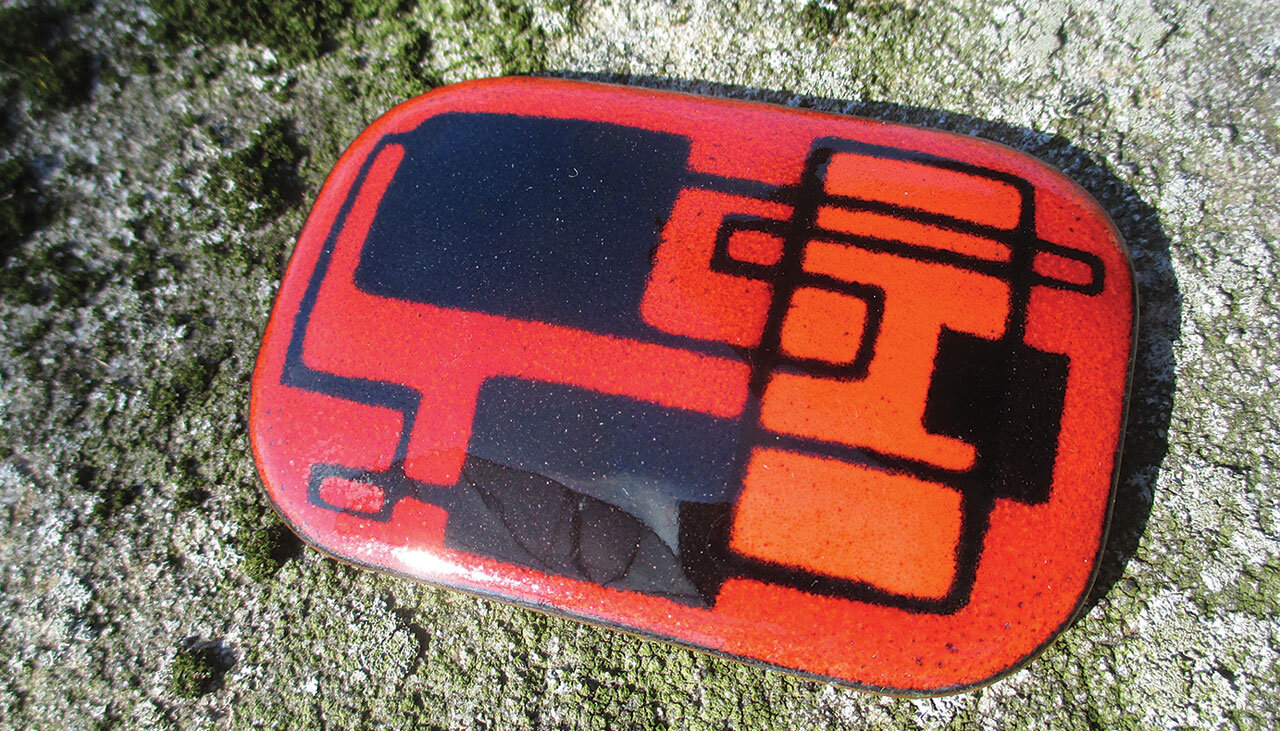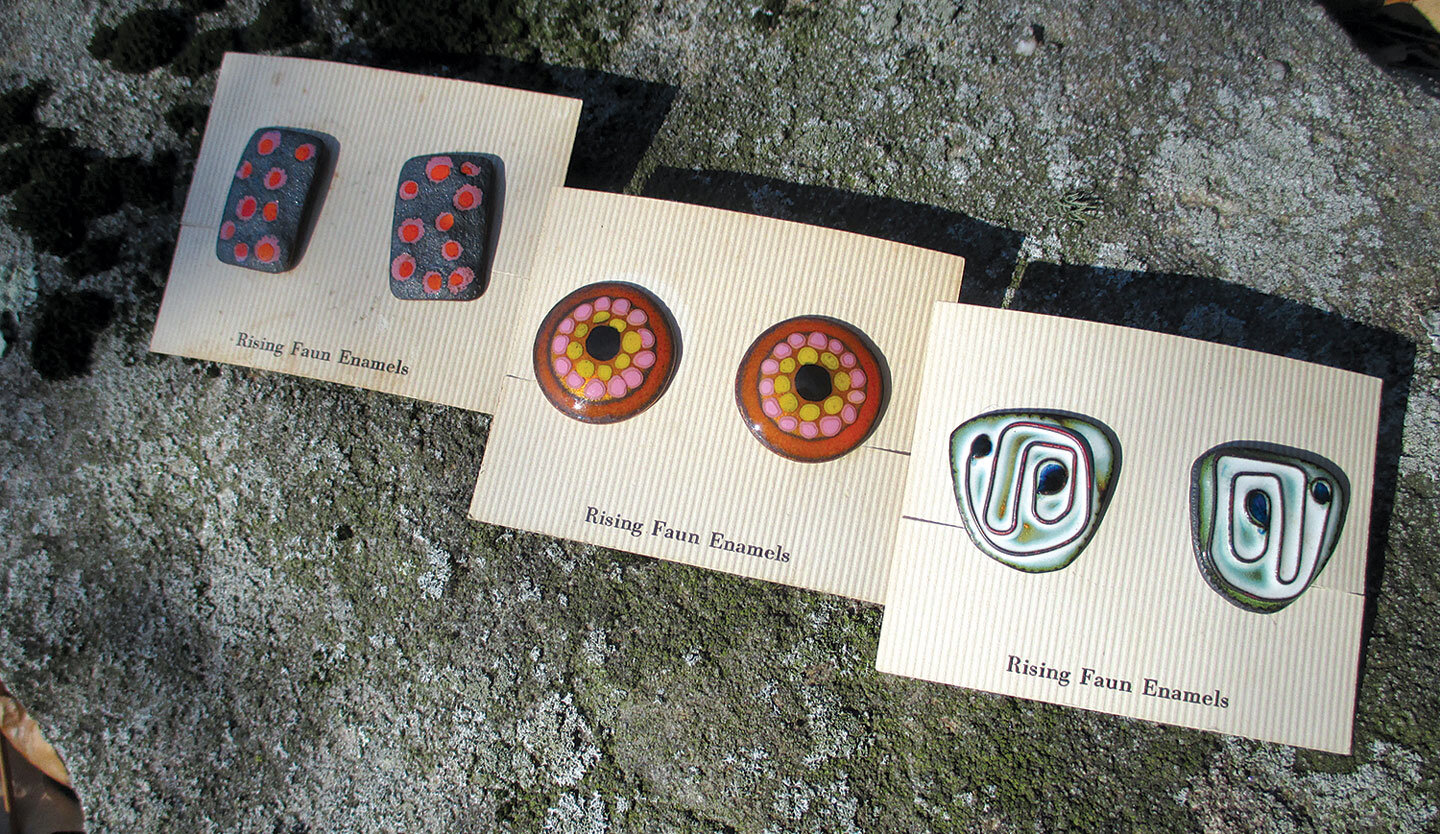Virginia Dudley 39.4
FISH BRACELET of enamel on copper with silver, 5.08 x 17.15 centimeters, circa 1955, illustrated in Design Quarterly, 1955. Collection of Patricia Antonia Collier.
Virginia Dudley was born in 1913 in the small town of Spring City, Tennessee, and grew up in Chattanooga, an industrial city nestled around a bend in the Tennessee River amid the dramatic scenery of the Cumberland Plateau. She practiced many artistic media—photography, printmaking, painting, sculpture, ceramics—and is best known for her award-winning enamels of the 1950s. The records documenting her life and career are fragmentary, but enough survives to indicate the impressive diversity of her artistic pursuits, her remarkable skill and vision, and her determined and independent personality. In an interview for the Chattanooga Times in 1962, she firmly expressed her passion for her vocation: “Everything I do is related to arts and crafts… It’s not a way of life, it is life to me. If not for that, I’d see no point in living.”
Dudley’s parents were not wealthy, but her mother encouraged her interests, and through a series of scholarships, Dudley pursued an art education. She first received a scholarship to the University of Chattanooga (now the University of Tennessee at Chattanooga), where she studied photography and painting from 1937-1940, earning a certificate of completion of art training. Then she won a scholarship to study in New York—a city she loved—at the Art Students League, where her instructors included William Zorach and Wil Barnet. While in New York, she also studied at the Craft Students League and served as Berenice Abbott’s photographic assistant at the New School for Social Research.
In 1943 she was awarded a Julius Rosenwald Fellowship and left New York to spend a year traveling in the South making photographs and sketches. Though most fellowships went to African American artists, some went to “white southerners with an interest in race relations,” as noted by the Spertus Museum in Chicago for an exhibition of Rosenwald-supported art. Dudley, as her niece Patricia Antonia Collier recalls, was staunchly opposed to segregation. Around this time, she acquired property in Rising Fawn, Georgia, on Lookout Mountain (near Chattanooga) and built a small home. She also married Oscar “Mac” McElhaney (1897-1944), a retired commercial photographer, who died near the end of her fellowship period.
After this loss, Dudley returned to the Art Students League, also studying at Stanley William Hayter’s Atelier 17, which he had relocated from Paris to New York when World War II began. During this second period in the city she met Joseph Spencer Moran (1923-2005), a graduate student in English at Columbia, and they married in 1946—though she again kept her given name.
Moran took a teaching job at New Mexico College in Las Cruces (now New Mexico State University), but Dudley told the Chattanooga Times (1955) that she did not relish the role of faculty wife. She enrolled in school briefly at New Mexico College, then in 1948 accepted a scholarship to Scripps College in Claremont, California, near Los Angeles, and did graduate work at Claremont Graduate School. Dudley had become enchanted by enamels while in New York, where she had seen an exhibition of medieval enameled objects at the Metropolitan Museum of Art, and Claremont was one of the few places in the country that offered enamel instruction. She studied with leading enamelist Jean Ames (1903-1986), who, with her husband Arthur (1906-1975), was part of “the development of a dynamic enameling movement in Southern California,” as Bernard N. Jazzar and Harold B. Nelson note in their book Little Dreams in Glass and Enamel.
During this time, Dudley also traveled to northern California where she visited Pond Farm, an artists’ colony founded by Jane and Gordon Herr that offered the Pond Farm Workshops from 1949-1952. There she encountered, as reported in the Chattanooga Times (1952), “artists from Austria and Germany who had, as she had, the thought that enameling was an art that should be revived.” She received her M.F.A. in 1950, creating a series of large enameled wall panels for her thesis as well as her own kiln.
American studio craft in all areas grew quickly in the post-war years—as returning G.I.s filled schools, academic programs expanded, and opportunities to exhibit and purchase craft multiplied—and the field of enamels was no exception. A relatively small niche within the craft world, enamels often was linked with ceramics, as both use kilns and involve the application of vitreous surfaces to grounds. Exhibitions like the Ceramics Nationals, which originated in Syracuse, New York, at the Syracuse Museum of Fine Arts (now the Everson Museum of Art), then traveled nationally, brought important media and public attention to contemporary ceramics and enamels. Dudley’s work appeared in many of the Nationals between 1949 and 1959, including the 16th in 1951, which featured two of her trays, Metropolitan and Golden Fishes, and the 19th in 1956 for which she won an award for enamels.
In 1950 Dudley returned to her home in Rising Fawn with Moran and they established Rising Faun Enamels—with a “u” rather than a “w” to distinguish from the town and to reference the mythological woodland creature—and created pins, pendants, necklaces, earrings, bracelets, tie clips, cufflinks, trays, and wall plaques or mosaics, that “sold in fine stores all over the country from New York to California” (Atlanta Journal and Atlanta Constitution, 1952). They worked with the Southern Highland Handicraft Guild, and Dudley explained, “The guild encourages craftsmen of the area by helping to exchange information, market products, and obtain raw materials.”
METROPOLITAN TRAY of enamel on copper, 20.32 x 20.32 centimeters, marked “rising faun enamels/virigina dudley” on back, circa 1951. Collection of Patricia Antonia Collier. Photograph by John Poehlman.
GOLDEN FISHES TRAY of enamel on copper, 22.2 x 25.4 centimeters, signed “rising faun enamels/virginia dudley” on back, circa 1951. Collection of Patricia Antonia Collier. Photograph by John Poehlman.
During the 1950s Dudley and Moran expanded the one-room cabin by adding a studio, living room and kitchen. Andrew Sparks described the home in the Atlanta Journal and Atlanta Constitution (1953) as “constructed largely of love and tarpaper, second-hand windows, old doors and lumberyard bargains.” He also referred to it as “one of the most interesting modern houses in Georgia,” noting, “the front yard is a cantilevered slab of sandstone that projects over an 87-foot vertical drop into a gorge that looks like a green-and-blue Grand Canyon.”
BIRD BROOCH/PENDANT of enamel on copper, 6.99 centimeters diameter, circa 1950-1957. Collection of Patricia Antonia Collier. Photograph by Ashley Callahan.
The house sits on the edge of a bluff overlooking Johnson’s Crook, a scenic bend in the valley, and is near both Tennessee and Alabama. Though the address is Rising Fawn, that town—the closest with a post office—sits at the base of the mountain, and the community at the top is referred to as New Salem. The area had developed a reputation as an artists’ colony, thanks to Fannie Mennen’s (1903-1995) efforts, starting in 1947, to organize annual art sales known as the Plum Nelly or Clothesline Art Show.
Dudley was resourceful and fiercely self-reliant, and the couple lived in the home without electricity for a couple of months, without a car for four years, and without running water. They enjoyed the seclusion, and the Chattanooga Times (1952) reported: “Here on Lookout Mountain, they found the freedom to build as they pleased, paint and draw when they wanted to, to fire up the furnace at midnight, if that hour is convenient for them.”
In 1954 Craft Horizons included a six-page illustrated article by Moran that details Dudley’s process. He wrote: “She is demonstrating through her studio-workshop that enameling can be an artistic medium of variety, subtlety and elegance, providing a modest livelihood for the hard-working practitioner.” He offered this description of her studio: “The nucleus of the workshop is the large table on which Virginia applies enamel to copper. This table, flanked on two sides by shelves containing jars of enamels, is directly beneath a skylight. To the right of the table stand the two kilns where the enamels are fired. A wood-burning space heater stands close to the chimney in the south wall.”
For larger works, like enamel plaques, Dudley made preparatory oil paintings, often dividing them into sections to plan basic colors and shapes. Moran prepared the copper, cutting and forming it as needed, and polishing it. Dudley applied the enamel—she had about three hundred colors—to the metal through a variety of methods to create different effects; Moran described how she sprinkled powdered enamel through a fine mesh screen, trailed it gradually between her fingers for a loose and linear effect, and painted “moistened enamel with a brush” for “the greatest control and precision.” Each piece, whether a pendant or a section of a mosaic, would be fired multiple times—usually just for a few minutes each time—to melt the enamel and fuse it to the metal, creating a thin, glassy surface. Small earrings usually required about six firings, while larger, more complex elements might require up to twenty-nine firings. Moran wrote that Dudley was “fascinated with the rich, latent possibilities to be wrought by the fusing of metal and enamels through intense heat,” and there was “always a tremor of excitement when we [opened] the kiln and [took] out an enameled piece.”
The Rising Faun Enamels are sophisticated in their range of techniques, variations in form, color combinations and complexity of layers. The metal is carefully shaped and the objects are finished on the back (counter enameled). Dudley achieved an impressive depth with her enamel, sometimes creating objects with opaque surface colors punctuated by small open areas revealing a translucency below that suggest dappled light shining into mountain streams. Her color combinations—even in miniature—are striking, with hot pink next to bright orange, or golden green below a vivid aqua. Her designs ranged from cubist-inspired geometrics to mid-century biomorphic forms, and she favored natural motifs, especially fish.
While Dudley incorporated her last name into the designs of most of the larger trays and plaques, or added her name, “rising faun enamels,” or “virginia and joseph” in enamel on the back, the jewelry is less consistently marked. Some larger pins and pendants have her name on the front, and some jewelry has paper labels on the back with “RISING FAUN ENAMELS/VIRGINIA AND JOSEPH” (sometimes with the line “FROM THE SOUTHERN HIGHLANDS”), but many items are unmarked.
While Rising Faun Enamels fit into the small world of studio enamels, it also fit into the growing field of modern studio jewelry, another area for which Dudley was recognized. In 1955 and 1959 the Walker Art Center in Minneapolis—a leader in promoting mid-century design and craft—included her work in two important issues of its publication Design Quarterly that were dedicated to contemporary jewelry. The 1955 issue, a who’s who of American mid-century jewelry, showed black and white photographs of two of Dudley’s bracelets, both composed of free-form sections, one abstract with light speckles on a dark ground and the other with fish. The 1959 issue included a pendant described as a “gold and silver encrustation on enameled copper,” and includes this quote from her: “I consider each piece of jewelry important within itself, a compatible object which intensifies the being of the wearer by heightening the presence and expanding the reality of the person.”
VIRGINIA DUDLEY working in her studio, circa 1954. Collection of Patricia Antonia Collier. Photograph by A. Glenn Hanson, Max Keister or Guy Hayes.
In 1954 Dudley explained, “When we built our studio, we were striving to solve a problem perplexing to many artists and craftsmen today: the problem of creating and marketing objects made by hand, with skill and sensibility, for those seeking not just the unique or unusual, but objects, well-made and functional, to gladden the discriminating who are so often wearied by mediocrity and monotonous repetition.” This goal may have been too idealistic, though, especially given their remote southern setting, and the next few years saw a shift in their approach as they worked to supplement their income. In 1955 they opened a retail shop in their home, American Craftsmen, selling Rising Faun Enamels as well as the work of about nine other craftsmen. By 1956 Dudley was teaching classes at the University of Chattanooga Evening College and at the Hunter Gallery of Art in Chattanooga, and in early 1957 she took a job with the Army directing arts and crafts recreational programs at Fort Monroe in Virginia. Though likely determined largely by financial concerns, this change may also reflect Dudley’s inclination to move on to new projects after she mastered a technique, a characteristic her niece remembers well. Dudley once stated, “A constant wariness of being trapped by one material, one approach, lives with me.” Her new job soon was followed by divorce, which marked the end of Rising Faun Enamels.
Dudley continued to include enamel work as part of her roster of activities in the following decades, but its prominence diminished. Also, by the 1960s, making enameled jewelry became a popular hobbyist activity, and kits with pre-cut flat forms and limited colors resulted in a saturation of the market that, as Jazzar and Nelson note in their book Painting with Fire: Masters of Enameling in America, 1930-1980, “began to undermine [enamel’s] status as a legitimate and highly regarded form of contemporary art.” Dudley returned to her earlier pursuits of travel and education, and maintained her Rising Fawn home as a weekend or summer retreat. From 1958-1959 she did post-graduate work at the College of William and Mary, and in 1959 at the University of Maryland’s overseas branch in Uijeongbu, Korea, where the Army transferred her to oversee more than a dozen craft shops, which she did until 1961 when she took up a similar role for the Air Force for two more years.
NECKLACE with metal choker. Shield is 6.03 x 9.21 centimeters. Jewelry is enamel on copper, circa 1950-1957. Collection of Patricia Antonia Collier. FISH BROOCH/PENDANT, 7.78 x 3.81 centimeters, paper label on back marked “VIRGINIA DUDLEY.” ABSTRACT BROOCH/PENDANT, 8.26 X 5.56 centimeters. EARRINGS ON RISING FAUN ENAMELS CARDS of enamel on copper, varying sizes, circa 1950-1957. Collection of Patricia Antonia Collier. Photographs by Ashley Callahan.
SEA BIRDS PANEL of enamel on copper, sand, paint, 81.28 x 48.26 centimeters, circa 1954. Collection of Georgia Museum of Art, University
of Georgia. Photograph courtesy of Georgia Museum of Art.
Even though she was moving on to new activities, Dudley’s reputation as an enamelist was well established. In 1957 Oppi Untracht, instructor in enameling at the Brooklyn Museum Art School, published the how-to book Enameling on Metal, which featured illustrations of several of her plaques/mosaics, including Sea Birds. Also, in 1959 the Museum of Contemporary Crafts in New York City (now the Museum of Arts and Design) included Dudley in its seminal exhibition titled “Enamels,” which included five of her works, from an early tray to recent jewelry.
During a visit to Rising Fawn in 1962 she discovered that her home had been burglarized, and that many of her finest works, both paintings and enameled plaques, as well as a box of clippings and catalogs, had been stolen. The local newspaper reported, “A quantity of ‘Rising Faun Enamels’ jewelry also was removed, including one-of-a-kind pendants, medallions and cuff links.” None of the material, valued at ten thousand dollars, was recovered, and the event remained a source of bitter frustration to Dudley.
From 1963-1971 she taught art at Shorter College, in Rome, Georgia, then, as her eyesight began to fail, retired to Rising Fawn. She died in 1981 at age sixty-seven. Though Rising Faun Enamels existed for only seven years—a brief passage in her productive life—that period of creative focus, entrepreneurial collaboration with Moran, and immersion in the natural beauty of her region resulted in a body of work that reflects both the captivating qualities she admired in the medieval enamels that first inspired her and the modernism of the mid-twentieth century.
SUGGESTED READING
Jazzar, Bernard N. and Harold B. Nelson, Little Dreams in Glass and Metal: Enameling in America, 1920 to the Present. Los Angeles: Enamel Arts Foundation, 2015.
—Painting with Fire: Masters of Enameling in America, 1930-1980. Long Beach: Long Beach Museum of Art, 2006.
Stevenson, Margie and Patricia Collier. “Virginia E. Dudley.” Chattanooga Regional Historical Journal 10: July 2007, 49-70.
Thomas, Joe A. Virginia Dudley and American Modernism, exhibition brochure, Zuckerman Museum of Art, Kennesaw State University, Kennesaw, Georgia, July 1-August 2, 2014.
Virginia Dudley website: http://www.virginiadudley.org.
Ashley Callahan is an independent scholar and curator in Athens, Georgia, with a specialty in modern and contemporary American decorative arts. After repeatedly encountering Virginia Dudley’s name for years while working on various research projects about craft in Georgia and modern jewelry, she became an admirer of Dudley’s accomplishments in the field of enamels, especially jewelry. She was thrilled when family friends Sally and John Poehlman of Rising Fawn put her in contact with the current occupant of Dudley’s amazing home, David Lyons, and with Dudley’s niece, Patricia Antonia Collier. Callahan appreciates the support, enthusiasm and warm welcome she and her husband enjoyed in Rising Fawn.








